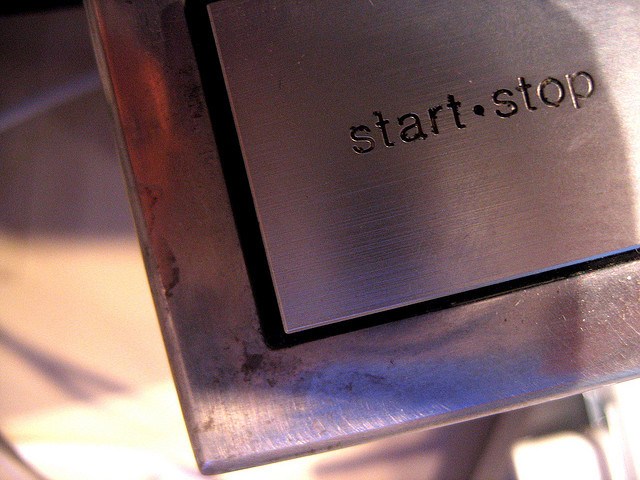
Backspins, Stops and Power-Offs
As you know all too well at this point, mixing is a process of making smooth blends between songs. That said, sometimes it’s more fun to forget about the smoothness and add some variety to your transitions. That’s when the spinbacks, power-offs and stops come into play – surely the showier ways to go from one track to another.
The Stop
Most vinyl turntables have electromagnetic brakes that stop the record more or less instantly after you’ve pressed the Stop button. The resulting sound is not too pretty but it can be used for cutting from one tune to another.
Beatmatch the new track to the one playing on the dancefloor and start it in your headphones as you normally do before making a blend. However, instead of starting to gradually bring in the new track to the floor, wait till the end of a phrase. On the phrase’s very last beat, hit Stop on the outgoing record’s deck and then quickly move the crossfader over to the new track – right in time for the first beat of the next phrase. That way, the old tune will instantly give way to the new one’s intro.
Here’s what it sounds like:
The Backspin
A backspin (also called spinback) is a characteristic effect produced by a record that’s given a quick spin in the reverse direction. It sounds very much like a fast rewind, which it essentially is. Just like a stop, a spinback can be used for making impressive cuts.
Before you try making a transition that involves a spinback, get a hang of giving the record a spin in the reverse direction. As the record is playing, take aim at the 12 o’clock spot on its outer edge. Catch the record at that spot with your middle finger and quickly (so that there’s no pause) push the record counterclockwise.
Warning: Backspins wear out vinyl in no time, so practice with the records you’d otherwise throw away.
There are a few ways to use a spinback in a transition. The first one is very much like using a stop. Instead of stopping the old track, however, you spin it back on the last beat of a phrase. Then, just before the record halts and begins to rotate clockwise, you quickly cut to the new tune by moving the crossfader over. Practice giving the record just enough of a push so the backspin ends within one beat, like here:
The second approach is more like a “normal” blend. You start the new track and begin to bring it in to the floor bit by bit, allowing it to get some momentum. Just before an important change in the new track (start of a bassline, for example), you backspin the old one and fully bring in the new tune, right in time for the banging part. Be creative!
The Power-Off
If you turn off a turntable while a record is playing, it won’t stop instantaneously but will gradually grind to a halt. As usual, one sample is worth a thousand words:
You can use power-offs in a number of ways:
- To create dramatic transitions between tracks. As the old track is approaching its ending, turn its turntable off and then slam in the new record from the other deck when the guests expect it the least.
- To stop the last track of the DJ you come after. A bit rude towards the guy, but hey, it’s the jungle of the club industry.
- If you’re buddies with the lighting guy, ask him to completely turn off the lights right when you turn off the turntable. The guests will freak out thinking there’s a power problem – a perfect moment for you to slam in one of those bombs from your record box, strobes flashing. The effect is unbelievable, I promise!
- To end your set. The sound of a record coming to a stop may be a good hint to the few very late guests that it’s time to say goodbye.
Speaking of ending the set, it’s time to conclude the article. Power-offs, spinbacks and stops may bring a lot of diversity into your mixing – but only if you follow two important pieces of advice. The first one is to hold your horses. If every transition you make is done either via a stop or a spinback, the guests will sooner or later come to a conclusion that you simply can’t mix. Second, master those tricks beforehand. They are very impressive but if you do them wrong (or in a wrong moment), you’ll sound very unprofessional.
Good luck!
About the Author JM
JM has played open-air gigs, shared the stage with the likes of ATB and had mix albums released commercially. He has been teaching DJing since 2008.
Session expired
Please log in again. The login page will open in a new tab. After logging in you can close it and return to this page.


Hi, this was very helpful. I just want to know the name of the song that you transitioned to in the backspin example.
Franky Boissy feat. Michael Watford – Back To Roots (Original 12″ Mix)
Awesome, thanks!
Great website. I’ve explored a lot of websites and videos on DJ tips but still managed to pick up some tips on here and I would recommend it to any beginner.
Hi, thanks for the job ur doing. Now I can mix some styles of music as dancehall.